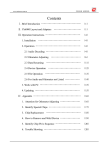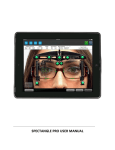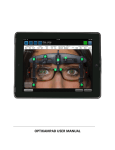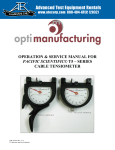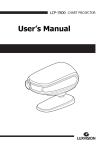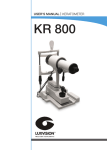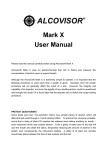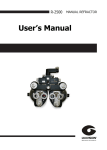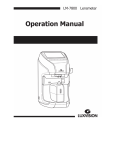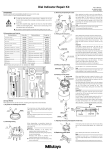Download Digital Pupilometer PM
Transcript
USER’S MANUAL PUPILOMETER PM 200 Notification Dear Users, Thank you for your purchase of PM 200 Pupilometer. Please take time to read our user’s manual carefully before use. This guarantees you to make full use of this unit and prolongs the operation life of this unit. Content 1. Function Introduction .....................................................................................4 2. Name of Parts ...............................................................................................5 3. Operation ....................................................................................................11 4. Maintenance ................................................................................................16 5. Specifications ..............................................................................................17 1. Function Introduction 1. Uses PM 200 is a digital precision optical instrument used to measure stance between human pupils in the process of optometry for fitting ectacles. 2. Characteristics This device is designed in a scientific and reasonable way, integrating technologies on optics, mechanism, electricity and microcomputer into whole. • Using an optical method to realize hairspring orientation which places the mechanical orientation • Adopting a full-digital design to effectively eliminate error optometrist’s artificial measurement, thus allowing objective and precise measurement of patient’s pupuillary distance • Save energy for low power design • A flexible baffle design convenient for storage which avoids possible embarrassment in operation. 4 2. Name of Parts 2.1 Description of the Front Panel (as shown in Fig.1) 8. Nose Bearer 4. Display Window 10. Observation Window 3. Lens Pupil Measuring Key 2. Right Pupil Measuring Key 1. Reset 6. Pupillary distance Conversion Key 7. Measuring State Transition Key 5. Memory key 9. Measuring Window Fig. 1 1. Reset Press this key to actuate the device. In the process of measurement, pressing the key will enable measured data of the device to be reset to the initial status. 2. Right Pupil Measuring Key It is used to measure right pupillary distance. Pressing outer side of the key will make pupillary distance pointer move towards nose bearer. At this time, the right eye pupillary distance and binocular pupillary distance reduce in numerical value, and then every pressing of the key allows pointer of the pupillary distance to move 0.5mm and Right data reduce by 0.5mm. Pressing inner side of the key will make the pupillary distance pointer move 5 in opposite direction of the nose bearer. Now numerical value of the pupillary distance increases, and every pressing of the key will enable the pupillary distance pointer to move 0.5mm, with Right data being increased by 0.5mm. 3. Left Pupil Measuring Key It is used to measure left pupillary distance. Pressing outer side of the key will make pupillary distance pointer move in opposite direction of the nose bearer. At this time, the left eye pupillary distance and binocular pupillary distance rise in numerical value, and then every pressing of the key allows pointer of the pupillary distance to move 0.5mm and Left data increase by 0.5mm. Pressing inner side of the key will make the pupillary distance pointer move towards the direction of the nose bearer. Now numerical value of the pupillary distance decreases, and every pressing of the key will enable the pupillary distance pointer to move 0.5mm, with Left data being reduced by 0.5mm. 4. Display Window (as shown in Fig. 2) It displays the measured numerical value of pupillary distance and some other relevant information. 1. Binocular Pupillary Distance 4. Reading of Binocular Pupillary Distance 3. Left Eye Pupillary Distance 2. Right Eye Pupillary Distance 6. Reading of Left Eye Pupillary Distance 5. Reading of Right Eye Pupillary Distance 11. Left Eye Measuring State 9. Binocular Measuring State 10. Right Eye Measuring State 8. Memory State 7. Display Value of Optic Distance Fig. 2 Note When reading information on the display window, the Right value denotes the distance between center of nose bridge and right eye pupillary distance, and the Left value denotes the distance between center of nose bridge and left eye pupillary distance. PD value stands for the distance between left eye pupil and right eye pupil. The unit is mm. 6 Important Matters Information on the reading display window do not appear simultaneously, instead, they will appear only when you need to measure a given state. 5. Memory Key It is used to store the current data. Press the key once to save the data and press again to cancel the saving. During the saving, the device’s function of measuring pupillary distance is deactivated, lighting source inside the device switches out and the device does not shut off automatically. 6. Pupillary Distance Conversion Key (TDIS) It is used to conduct conversion of measured value of pupillary distance at different optic distances of 30cm ~ ∞. 7. Measuring State Transition Key (BIN) Monocular pupil measurement of left or right pupil is realized by pressing this key, there by making conversion of left or right pupil measurement and simultaneous binocular pupils measurement available. 8. Nose Bearer A testee’s bridge rests on the nose bearer so that the device and position of the testee’s pupil is fixed. 9. Measuring Window The working window of the testing personnel. 10.Observation Window Two windows provided for a testee to stare at the target with His (her) eyes. 7 2.2 Description of Rear Panel (as shown in Fig.3) 5. Forehead Bearer 2. Baffle Switch 1. Baffle 3. Battery Box 4. Preset Screw Fig. 3 1. Baffle It is located at bottom of the instrument. For operation, turn on the switch and then lay down the baffle to separate observer and testee. 2. Baffle switch It may move up and down to draw in and lay down the baffle. 3. Battery box Two battery boxes are available at the bottom of the device, one on the left side and the other on right side, each with 2 pieces of 5# AA batteries. 4. Preset screw It is located under the baffle, which is visible only after the baffle is laid down. The specification is English standard 1/4”, a camera tripod can be fixed for the convenience of user. 8 5. Forehead bearer The testee’s forehead reasts on the forehead bearer so that the position of his pupils is fixed. 2.3 Viewed from the Measuring Window (as shown in Fig.4) Pupillary Distance Pointer The widths in the observation windows of the device are 0.45mm vertical black lines, one in the left window and the other in the right window. Pressing measuring keys of the left and right pupils will make the pointer move on the reflecting light dot of the human pupil, thus permitting measurement of the pupillary distance. Pupillary distance pointer Observation window Fig. 4 Important Matters When the single-face pupillary distance pointer reaches the maximum or minimum range of measurement (maximum value 41.5mm as shown in Fig.5 a or 22mm as shown in Fig.5b) after pressing left or right pupillary distance measuring key to move the pupillary distance pointer, the area of measuring window outside the range of measurement becomes black. At this time, the pupillary distance pointer is invisible in the measuring window and can be observed only after adjusting the left or right measuring key of pupillar distance in reverse. 9 Black area Black area Observation window Fig.5a (It is the state of the observation window when pupillary distance pointer reaches 41.5mm) Observation window Black area Black area Observation window Fig.5b (It is the state of the observation window when Pupillary distance pointer reaches 22mm) 2.4 Viewed from the Observation Window (as shown in Fig.6) Target to be stared at In the middle of an eyeball-shape circle in the center of the device’s inner visual field, there is a green target image surrounded with a bright ring. A testee should stare at the target with both eyes. 10 Measuring window Bright ring Target to be stared at Green area Fig. 6 3. Operation This is a high-tech intelligent instrument, which is very easy to operate. Please operate it according to the following procedures, thus you can get measured data easily and rapidly. 3.1 About Battery Before using the device, please put 4 pieces or 2 pieces of 5# AA batteries into its battery box. Warning: • Only high energy alkali battery is applicable, and please do not use common acidic one so as to avoid leak age of battery liquid which may cause damage to the device. • Be care about the polarity of the battery when replacing it. • Properly dispose of the used battery to avoid environmental pollution. 11 3.2 About Baffle Open the baffle (as shown in Fig. 7) Push the baffle switch in the arrow direction, thus the baffle can be opened. Fig. 7 3.3 Start-Up (as shown in Fig.8) Press RESET key to make the start-up of the device initialized. After that a microprocessor in the device sets and right pupillary distance pointers at the middles of the left and right measuring windows, and the data on the corresponding digital liquid crystal display windows are shown as follows respectively: LEFT 31.5mm, RIGHT 31.5mm and PD 63mm, where, optic distance is set as ∞ and BIN as the state of simultaneous binocular measurement. Then you are able to conduct measurement. Fig.8 (It is the state of start-up and display window when binocular pupillary distance is measured) 3.4 Measurement of Binocular Pupillary Distance (as shown in Fig.8) 3.4.1 Start-up The initialized setting of the device is just the binocular pupillary distance for measuring ∞ optic distance. 12 3.4.2 Put the nose bearer lightly on testee’s nose bridge and keep the device in a horizontal state. 3.4.3 Let the testee stare at the staring target of the device. Important Matters In the process of measurement (and the measurement of monocular pupillary distance described in the following section), to achieve precise data of measurement and make process of measurement easily and quickly, the tester should remind the testee to always stare at the Staring Target in a level state, without moving his (her) eyeballs. 3.4.4 The tester observes the reflecting bright dot on the testee’s pupil through measuring window. Press the Left and Right Pupils Measuring Keys, the left and right pupillary distance pointers will coincide the reflecting bright dots of the testee’s left and right pupils, respectively. The datum shown in the display window is just the measured pupillary distance. 3.5 Measurement of Monocular Pupillary Distance (as shown in Fig. 9a and 9b) 3.5.1 Start-up. The initialized setting of the device is just the binocular pupillary distance for measuring ∞ optic distance. 3.5.2 Press Measuring State Transition Key (BIN) to choose mode of measurement, and it will indicate on the lower right corner of the display window. When L is shown, it means only left pupillary distance will be measured, and R for measuring right pupillary distance. 3.5.3 Put the nose bearer lightly on the testee’s nose bridge and keep the instrument in a horizontal state. 3.5.4 Let the testee to stare at the Staring Target of the device. 3.5.5 The tester observes the reflecting bright dot on the testee’s pupil through measuring window. Press the Left or Right Pupil Measuring Key, the left or right pupillary distance pointer will coincide the reflecting bright dot of the testee’s left or right pupil, respectively. The datum shown in the display window is just the measured pupillary distance. Fig.9a (It is the state of the display window when right eye pupillary distance is measured) 13 Fig.9b (It is the state of the display window when Left eye pupillary distance is measured) Important Matters When measuring right eye pupillary distance, the right observation window is in the state of measurement, and left observation window becomes the following state: immeasurable area is black and measurable area is black-white strip, and then pupillary distance pointer is invisible (as shown in Fig. 10a). Pupillary distance pointer Black area Observation window Black-white strip area Black area Fig.10a (It is the state of the observation window when Right eye pupillary distance is measured) When measuring left eye pupillary distance, the left observation window is in the state of measurement, and the right observation window becomes the following state: immeasurable area is black and measurable area is black-white strip, and then pupillary distance pointer is invisible (as shown in Fig. 10b). 14 Black-white strip area Black area Pupillary distance pointer Black area Observation window Fig.10b (It is the state of the observation window when Left eye pupillary distance is measured) 3.6 Memory of the Measured Data (as shown in Fig. 11) Press MEM Key to store the measured data so as to avoid change of the measured data due to misoperation of some other key. Fig.11 3.7 Conversion of Pupillary Distance at Different Optic Distances (as shown in Fig. 12) Press Pupillary Distance Conversion Key (TDIS) to get the pupillary distance conversion values at different optic distances such as 30cm, 35cm, 40cm, 50cm, 65cm, 1m, 2m and ∞. Fig.12 Note: The optic distances shown in the figure do not appear in the display window simultaneously. It just shows the optic distance whose pupillary distance needs to be converted. 15 Example: If you want to convert the pupillary distance at 40cm optic distance when the measured infinite far left or right monocular pupillary distance is 32.5mm and binocular pupillary distance 65mm (as shown in Fig.13a), press Pupillary Distance Conversion Key (TDIS) to choose the optic distance 40cm which needs to be converted, and the converted values show that left or right monocular pupillary distance is 30.5mm and binocular pupillary distance 61mm (as shown in Fig.13b). Fig.13a Fig.13b Important Matters The pupillary distance actually measured by the PM 200 is the pupillary distance at the distance of ∞ far target, and pupillary distances at the distances of other targets are obtained through calculation, only for reference. 4. Maintenance 4.1 It has been precisely adjusted before delivery. Please do not dismantle it so as to keep it precise. 4.2 It shall be stored and used in an indoor well-conditioned dry place. 4.3 As a high-tech product, the device shall be prevented from Vibration or impact. 4.4 Keep it clean and do not touch surface of its window glass. Fingerprint, dust or stain should be cleaned with absorbent cotton dipped with mixed solution of alcohol and ether. 4.5 Any corrosive chemical is forbidden for cleaning it. 4.6 In case of malfunction, do not dismantle it by yourself. Please contact the local sales agent or the manufacturer for help. 4.7 Provided there is no display on the display window after startup, please check the polarity of the battery to see if it is well placed and electrified. 16 5. Specifications Binocular pupillary distance 44 ~ 83mm Left or right pupillary distance 22 ~ 41.5mm Binocular pupillary distance 45 ~ 82mm Left, right pupillary distance 22.5 ~ 41mm Indication error ≤ 5mm Rounding error ≤ 0.5mm Distance of target 30cm ~ ∞ Power source Voltage: DC 3V Specification: 5#AA battery Quantity: 2 or 4 pieces Time for automatic shut-off 1 and a half minute after stopping operation Size 219mm(L) X 169mm(W) X 64mm(H) Weight 0.6kg 17 LUXVISION is not responsible or liable for indirect, special or consequential damages arising out of or in connection with the use or performance of the product or damages with respect to any economic loss, loss of property, loss of revenues or profits, loss of enjoyment or use, costs of removal or installation or other consequential damages of whatsoever nature. Some states do not allow the exclusion or limitation of incidental or consequential damages. Accordingly, the above limitation may not apply to you. Every effort has been made to ensure the accuracy of this manual. However, LUXVISION, makes no warranties with respect to the documentation and disclaims any implied warranties of merchantability and fitness for a particular purpose. LUXVISION, Inc. shall not be liable for any errors or for incidental or consequential damages in connection with the furnishing, performance, or use of this manual or the examples herein. The information in this document is subject to change without notice. 18



















